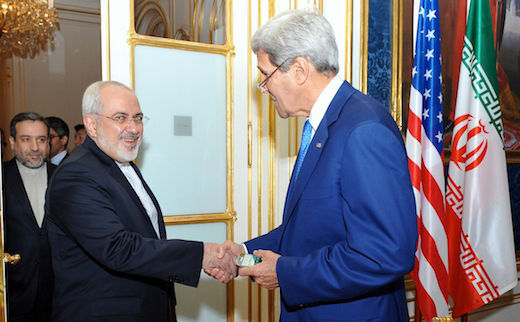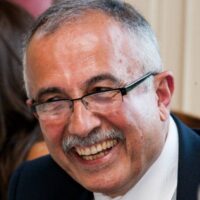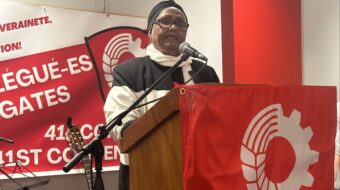
The West and Iran are portrayed by certain sections of the media as being at loggerheads over policy in the Middle East towards the Islamic State (IS, otherwise known as ISIS or ISIL). The reality on the ground is quite different. Jamshid Ahmadi, assistant general secretary of CODIR (Committee for Defence of the Iranian People’s Right), UK-based solidarity campaign reports.
The official line in both Washington and Tehran is that there is no cooperation between the two states in the struggle against the Islamic State across Syria and Iraq. In relation to the recently announced international summit in Paris last week, on cooperation to fight the Islamic State, U.S. Secretary of State John Kerry suggested Iran’s involvement “wouldn’t be appropriate,” although Kerry did modify this stance a few days later.
Officially, the Iranians had been no less forthright initially. In a statement on his official website, Iran’s Supreme Leader Ayatollah Ali Khamenei said, “Right from the start, the United States asked through its ambassador in Iraq whether we could cooperate. I said no, because they have dirty hands.”
However, the Supreme Leader, as the main decision maker on foreign policy matters, including negotiations with the U.S., has given 100 percent backing to President Rouhani’s efforts and has called on all factions of the regime to support the president’s efforts.
The media in both the U.S. and Iran are keen to portray the standard images of either side. The Iranian media insists that, for the vast majority of Iranians, the United States remains the “Great Satan.” For the American public, Iran remains part of the Axis of Evil, as declared by President George Bush in 2001.
The reality, however, is that more complex factors are at play. The generally accepted position in relation to IS in Iraq, for example, is that the Iranians have no desire to see a militant Sunni jihadist state on its borders. While this is true, it is not, for the Iranians, the main consideration.
The lifting of Western sanctions and a stabilizing of the relationship with the United States has been a covert central objective of Iranian foreign policy at least since 2010. Since then, and before the June 2013 presidential election in Iran, there is evidence of three secret meetings, which had taken place at a high level between the U.S. and Iran, mediated by the government in Oman. It is as a result of these contacts and open dialogue during the past 16 months that the U.S. and Iran are able to communicate over the immediate issue of the IS.
In the current situation Iran’s cooperation with the West has gone as far as complicity in the removal of Nouri al-Maliki, a fellow Shia Muslim, as Iraqi Prime Minister. Iran for years was the main backer of Maliki’s government and his Shia governing alliance. Suddenly in 2014 he fell out of favor for no obvious reason but the fact the U.S. had its eye on other methods of governing Iraq. Maliki’s administration was deemed too sectarian. The exclusion of Sunnis and others from government was seen as part of the reason for the success of IS in northern Iraq.
In a recent interview with U.S. broadcaster CNN, Iraqi President Fuad Masum was asked whether it was a combination of U.S. airstrikes, with Iraqi fighters and Iranian militiamen, that helped liberate the town of Amerli. He confirmed that it was.
Video footage has emerged showing Iran’s top military commander, Qassem Soleimani, on the frontlines of the battle against IS alongside Iraqis trained and instructed by the U.S.
There are also reports that the Iranian air force participated in a coordinated bombardment of IS positions, along with U.S. fighters, on the first day of air operations in Iraq.
It is clear that both the practical fact of cooperation and the mutual denials that it is happening suits both sides. The U.S. can avoid the awkward issue of justifying to powerful lobbies in Washington working with a country it condemns and continues to sanction. The West also gets to avoid angering its Sunni friends in the Gulf monarchies.
For its part the Iranian regime, while saving face publicly by not being seen to be part of the Western camp, remains desperate to have sanctions lifted. The regime calculates that cooperation in Iraq will help pave the way to Iran being seen as a stable force in the region and a state with which the West can ultimately do business. The fact is that the Iranian economy has become a hostage to U.S. sanctions and the Iranian regime is prepared to bow to U.S. bidding to get these removed.
The question is how far the U.S. is prepared to push Iran to test its loyalty. The U.S. plan for the future of Syria is a major test.
In the short term, once the border is crossed into Syria, the relationship between the U.S. and Iran becomes more complex, with Tehran supporting the government of President Assad, while the U.S. continues to support the opposition insurgency. For their different reasons, even here, both are committed to defeating IS. While practical cooperation may not be an option in Syria at present, the immediate objective in relation to IS remains a common one. Whether this could widen out into some form of joint approach to the situation in Syria remains to be seen.
The immediate question of Syria aside, the ground has been laid for U.S.-Iranian cooperation over a period pre-dating the election of Hassan Rouhani to the Iranian presidency in June 2013. It has been in the interests of both the United States and Iran to build a rapprochement aimed at redefining their relationship and protecting the interests of both in the Middle East.
For more than a decade the U.S. has been engaged in large-scale military invasions with the commitment of huge quantities of hardware and personnel to the Persian Gulf. However, there has been only limited success in stabilizing the situation in favor of U.S. control of the region’s markets and natural resources. The financial costs and the negative political fallout from massive U.S. military operations have significantly negated their benefit while incurring astronomic costs.
Also, during the last decade, the international complications arising from large-scale U.S. military intervention have significantly increased. Public opinion in the U.S. and globally has turned against costly direct military interventions in distant countries. This is partly due to the effectiveness of global antiwar and peace movements in Europe and North America. Large-scale U.S. military action has not produced the desired outcomes in line with the interests of global capitalism due to unpredictable fluctuations in the price of oil, the possibility of disrupting the flow of oil from the region, and the exchange rate of the dollar.
Political developments in the region suggest that a reconfiguration of U.S. politics in the Middle East is taking place. The desire to bring together a coalition of Middle East and Arab states before air strikes commenced in Syria for example was an indication of this change.
Part of this reconfiguration is aimed at the inclusion of “Political Islam” into a New Middle East Plan, on the part of the U.S., with Iran’s theocratic regime being seriously considered as a key player. If successful, the new configuration in the Middle East will allow the U.S. to influence and steer key regional developments in order to reinforce and perpetuate its global economic, political and military hegemony.
There are also indications that the U.S. and EU have reached some agreement about Iran playing a key part in securing stability in Afghanistan and Pakistan after the departure of U.S., British and NATO troops from Afghanistan at the end of 2014. If current developments proceed according to plan, Western countries will not oppose Iran playing a key role in securing the future of the present set-up in Afghanistan. A key factor influencing this is undoubtedly the political clout wielded by the Iranian regime in Iraq, Syria, Lebanon and Afghanistan.
In this context the cooperation of the U.S. and Iranian forces to defeat the IS insurgency does not look as far-fetched as it at first appears.
Photo: U.S. Secretary of State John Kerry shakes hands with Iranian Foreign Minister Mohammad Javad Zarif as he arrives at a hotel in Vienna, Austria, on July 14, 2014, for a second day of meetings about the future of his country’s nuclear program. (State Department/Public Domain)









